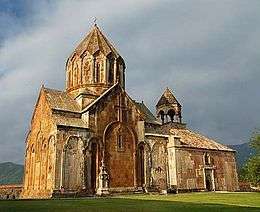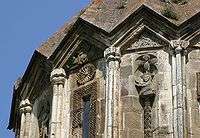Gandzasar monastery
| Gandzasar | |
|---|---|
.jpg) | |
 Shown within Nagorno-Karabakh Republic | |
| Basic information | |
| Location |
near the village of Vank, Martakert province, |
| Geographic coordinates | 40°03′25″N 46°31′52″E / 40.056839°N 46.531233°ECoordinates: 40°03′25″N 46°31′52″E / 40.056839°N 46.531233°E |
| Affiliation | Armenian Apostolic Church |
| Year consecrated | July 20, 1240 |
| Ecclesiastical or organizational status | Functioning |
| Website | www.gandzasar.com |
| Architectural description | |
| Architectural type | Monastery, Church |
| Architectural style | Armenian |
| Completed | 1238 |
Gandzasar monastery (Armenian: Գանձասարի վանք) is a 10th to 13th century Armenian monastery situated in the Mardakert district of de facto Nagorno-Karabakh Republic (de jure: Kalbajar Rayon). "Gandzasar" means treasure mountain or hilltop treasure in Armenian.[1] The monastery holds relics believed to belong to St. John the Baptist and his father St Zechariah.[2]
Gandzasar is now the seat of the Archbishop of Artsakh appointed by the Mother See of Holy Etchmiadzin of the Armenian Apostolic Church.
History and architecture
The monastery at Gandzasar was first mentioned in the tenth century.[3][4] The construction of Gandzasar's Cathedral of St. John the Baptist began in 1216, under the patronage of the Armenian prince of Khachen, Hasan-Jalal Dawla, and it was completed in 1238 and consecrated on July 22, 1240.
In the 14th century, after the fall of the Armenian kingdom of Cilicia resulted in a decline in the influence of the Sis catholicosate and the re-establishment of a catholicosate at Etchmadzin, a regional catholicosate emerged in Artsakh. Gandzasar monastery became the headquarters of the Catholicosate of Aghvank, also known as the Holy See of Gandzasar. Adalian considers its foundation to be as a result of an ancient bishopric seeking "ecclesiastical autonomy to compensate for the lack of control and communication from a central pontificate" and part of various local strategies in an Armenia dominated by foreign and Islamic rule to "preserve some semblance of religious authority among the people". In the 16th century it became subordinate to the Etchmiadzin catholicosate.[5] Many of its catholicoi were members of the Hasan-Jalal Dawla dynasty. [6]
The complex is protected by high walls. Within the complex is the Cathedral of St. John the Baptist (Սուրբ Յովհաննու Մկրտիչ եկեղեցի in Armenian), built between 1216 and 1238.[7] The drum of its dome has exquisite bas-reliefs that depict the Crucifixion, Adam and Eve, and two ministers holding a model of the church above their heads as an offering to God. The bas-reliefs have been compared to the elaborate carvings of Aghtamar,[8] and some art historians consider the monastery to represent one of the masterpieces of Armenian architecture. Anatoly L. Yakobson, a prominent Soviet medieval art historian, described Gandzasar as a "pearl of architectural art....This is a unique monument of medieval architecture and monumental sculpture, which by right ought to be regarded as an encyclopedia of 13th-century Armenian art."[9]
Gandzasar's cathedral church shares many architectural forms with the main churches of two other Armenian monasteries also built in the mid-13th century: Hovhannavank Monastery and Harichavank Monastery.[10][11]
Gallery
- widths="130px"
 Gandzasar Monastery
Gandzasar Monastery Gandzasar Monastery
Gandzasar Monastery Drum of the Cathedral of St. John the Baptist
Drum of the Cathedral of St. John the Baptist Interior of the Cathedral of St. John the Baptist
Interior of the Cathedral of St. John the Baptist Gandzasar bas-reliefs
Gandzasar bas-reliefs Royal flag of Hasan-Jalal Vahtangian (reigned 1214-1261), founder of the Cathedral of St. John the Baptist
Royal flag of Hasan-Jalal Vahtangian (reigned 1214-1261), founder of the Cathedral of St. John the Baptist Armenian medieval lapidary inscriptions on Gandzasar's walls
Armenian medieval lapidary inscriptions on Gandzasar's walls
See also
| Wikimedia Commons has media related to Gandzasar. |
Notes
- ↑ Thus, the name divided into syllables, Գանձ+ա+սար, is translated as գանձ = treasure; սար = mountain or hilltop, with the letter "-ա-" (-a-), forming an agglutinative compound.
- ↑ Kirakos Gandzaketsi. History of the Armenians, Sources of the Armenian Tradition. New York, 1986, p. 67.
- ↑ Anania Mokatsi. On the Rebellion of the House of Aghvank. Yerevan, Luis, 1956, p. 14
- ↑ Chorbajian, Levon; Donabedian Patrick; Mutafian, Claude. The Caucasian Knot: The History and Geo-Politics of Nagorno-Karabagh. NJ: Zed Books, 1994
- ↑ Rouben Paul Adalian, "Historical Dictionary of Armenia", 2nd edition, 2010, p128-129.
- ↑ http://www.gandzasar.com/holy-see-of-gandzasar.htm
- ↑ Khatcherian, Hrair (1997). Artsakh: A Photographic Journey. Eastern Prelacy of the Armenian Apostolic Church of America, p. 13.
- ↑ See Comneno, Lala M., Cuneo, P, and Manukian, S. Volume 19: Gharabagh. Documents of Armenian Art - Documenti di Architettura Armena Series. Polytechnique and the Armenian Academy of Sciences, Milan, OEMME Edizioni, 1980, Introduction
- ↑ Hakobyan, Hravard H (1990). The Medieval Art of Artsakh. Yerevan, Armenian SSR: Parberakan. p. 76. ISBN 5-8079-0195-9.
- ↑ Thierry, Jean-Michel and Patrick Donabedian. Les Arts Arméniens. Paris, 1987.
- ↑ Thierry, Jean. Eglises et Couvents du Karabagh. Antelais, Lebanon, 1991, pp. 161-165
Further reading
- (Russian) Yakobson, Anatoly L. “From the History of Medieval Armenian Architecture: the Monastery of Gandzasar,” in: Studies in the History of Culture of the Peoples in the East. Moscow-Leningrad. 1960.
External links
- Gandzasar.com - Gandzasar Monastery, Nagorno Karabakh Republic (official site)
- Program about Gandzasar Monastery by Vem Radio



.jpg)
